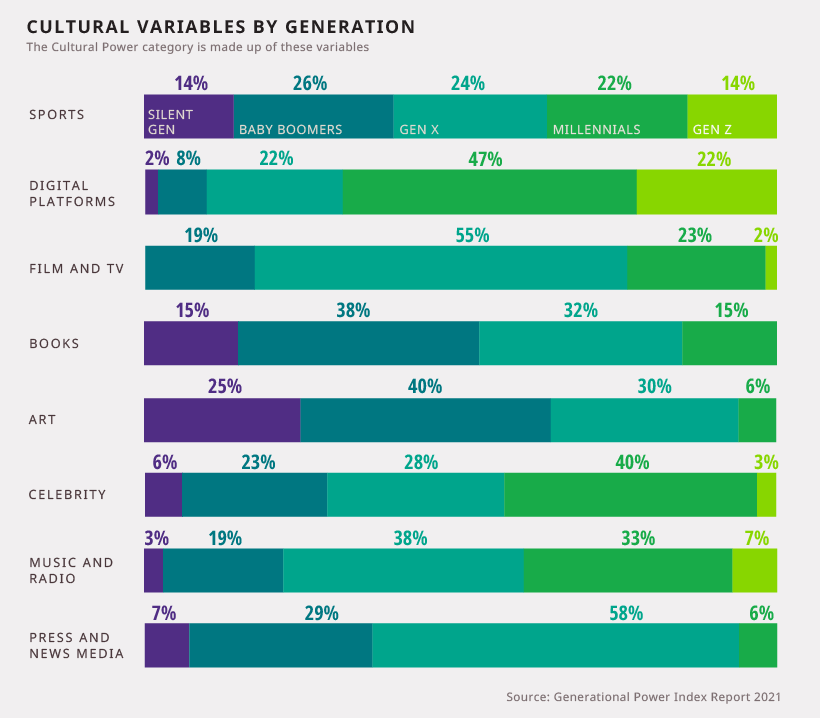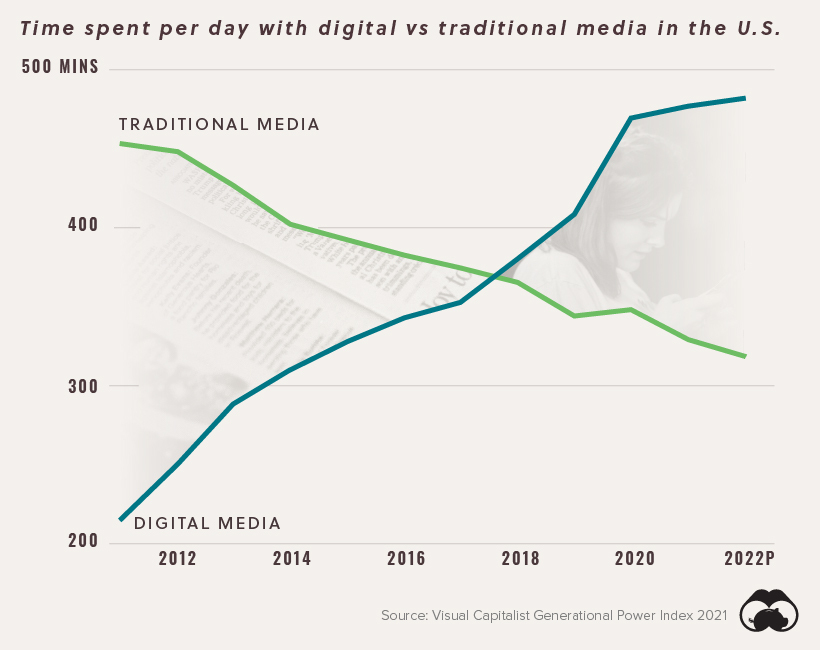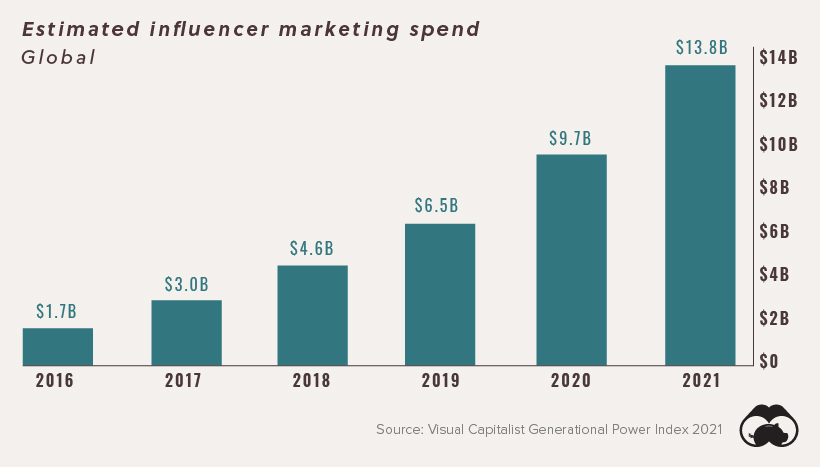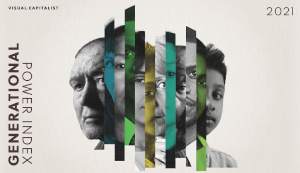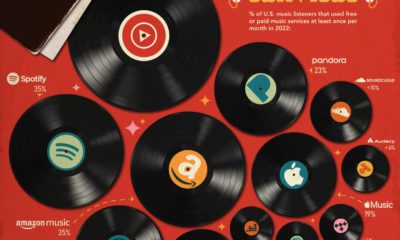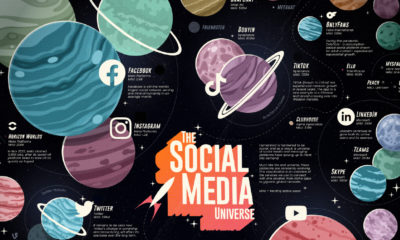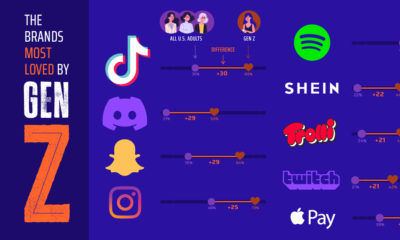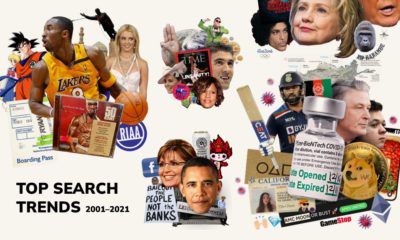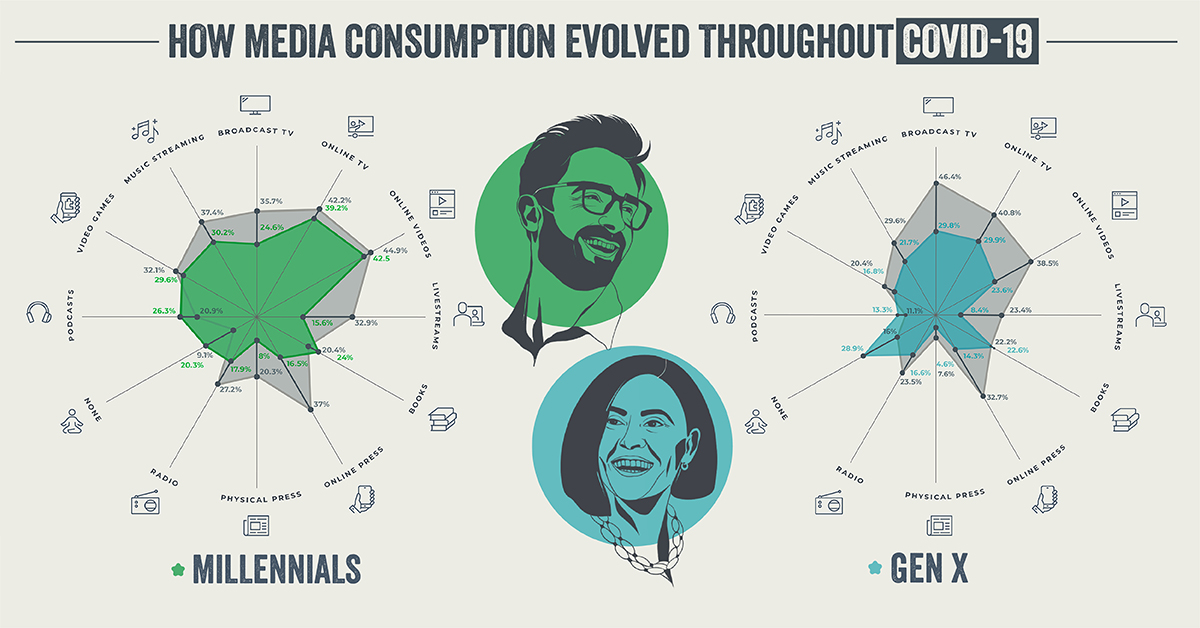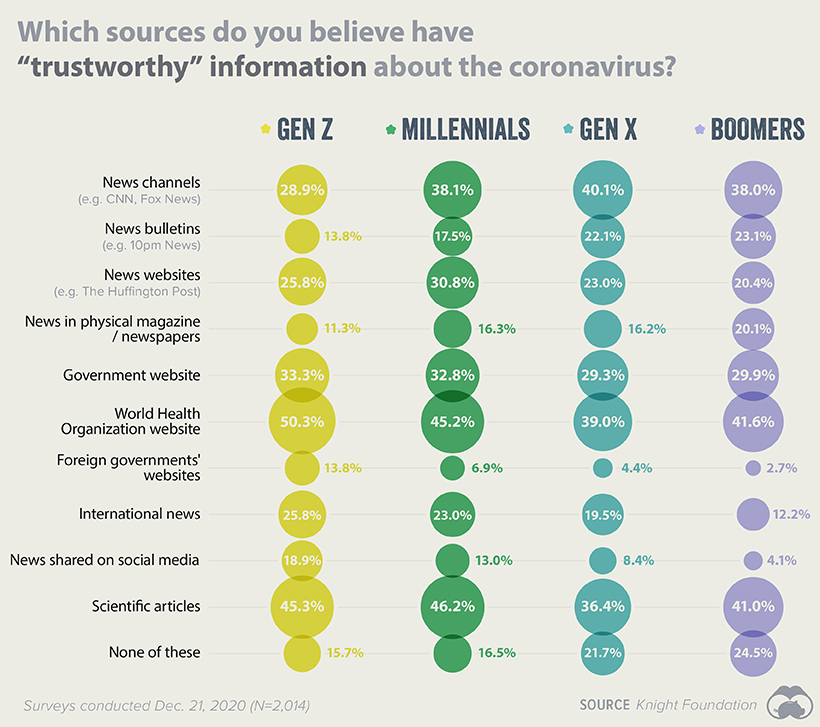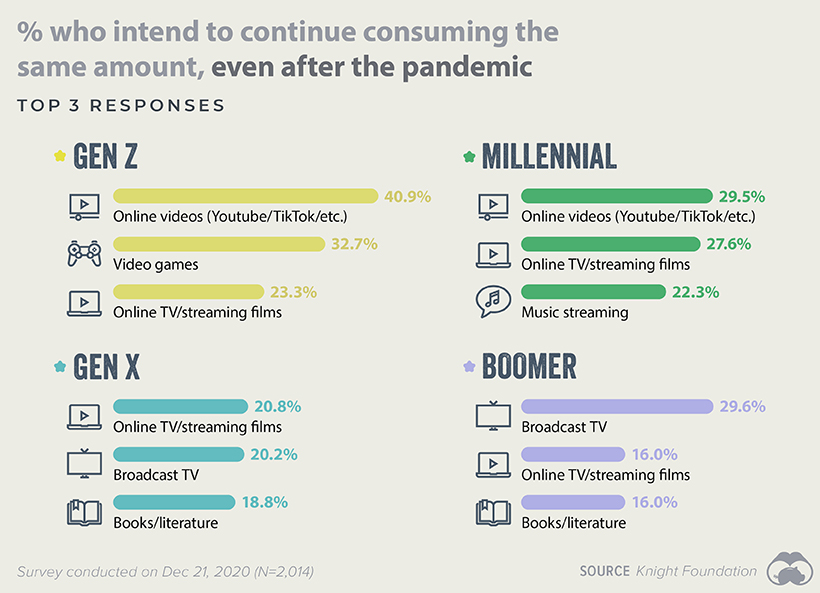We considered three categories in our quest to quantify power: economics, political, and cultural. And while it turns out Baby Boomers dominate when it comes to economics and political factors—cultural influence is a different story. Here’s a look at which U.S. generation holds the most cultural power, and how this power dynamic is expected to shift in the coming years.
Generations and Power, Defined
Before we get started, it’s important to clarify which generations we’ve included in our research, along with their age and birth year ranges. Using these age groups as a framework, we then calculated the Cultural Power category using these distinct equally-weighted variables:
With this methodology in mind, here’s how the Cultural Power category shakes out, using insights from the GPI.
Share of Cultural Power by Generation
Overall, we found that Gen X captures the largest share of cultural power, at 36%. *Note: figures may not add up to 100% due to rounding. Gen X is particularly dominant in the film and TV industry, along with news media. For instance, over half of America’s largest news corporations have a Gen Xer as their CEO, and roughly 50% of Oscar winners in 2020 were members of Gen X. Baby Boomers come in second place, capturing a 25% share of cultural power. They show particular dominance in traditional entertainment like books and art. For example, 42% of the authors on the NYT’s best-selling books list were Baby Boomers. However, these older generations fall short in one critical category—digital platforms.
The Dominance of Digital
Why is digital so important when it comes to cultural power? Because digital media becoming increasingly more popular than traditional media sources (e.g. TV, radio).
In 2020, Americans spent nearly 8 hours per day consuming digital media, nearly two hours more per day than they spent with traditional media. This divide is expected to grow even further over the next few years. With younger generations dominating the digital space, Gen X may soon lose its place as the top dog of the culture category.
Celebrity 2.0: The Social Influencer
As audiences flock to online channels, advertisers have followed suit—and they’re willing to spend good money to gain access to their target demographics. In fact, spend on influencer marketing has steadily increased in the last five years, and it’s expected to reach $13.8 billion by the end of 2021.
This shift to social media advertising is redefining the notion of celebrity, and who reaps the financial benefits of content creation. For instance, six-year-old Vlogger Like Nastya made an estimated $7.7 million per month from her YouTube channel in 2020. And keep in mind, this estimate is purely based on YouTube revenue—it doesn’t even include corporate partnerships and/or merchandise sales. With all these shifts occurring, culture as we know it is at a crossroads. And as we continue to move towards a digital dominant society, those who hold power in traditional realms will either adapt or pass along the torch. Download the Generational Power Report (.pdf)
on Media consumption spiked in the early days of the COVID-19 outbreak as Americans actively sought information and entertainment while at home. Whether this changed over the course of 2020 remains unclear, however. To dive deeper into the issue, this infographic explores each generation’s shifts in media consumption habits as the pandemic wore on. Further below, we’ll also examine which media sources Americans deemed to be the most trustworthy, and why consumption habits may have changed for good.
Changes in American Media Consumption, by Generation
The data in this infographic comes from two surveys conducted by Global Web Index (GWI). The first was completed in April 2020 (N=2,337) and asked participants a series of questions regarding media consumption during COVID-19. To see how consumption had changed by the end of the year, the John S. and James L. Knight Foundation commissioned GWI to complete a follow-up survey in December 2020 (N=2,014). The following tables provide a summary of the results.
Gen Z
Unsurprisingly, a significant percentage of Gen Z reported an increase in digital media consumption in April 2020 in comparison to pre-pandemic habits. This bump was driven by higher use of online videos, video games, and online TV/streaming films. By December 2020, these media categories became even more popular with this cohort. Most notably, podcasts saw the highest increase, jumping almost 15% by the end of the year. The popularity of traditional outlets like broadcast TV and radio declined from their April 2020 highs, though they are still up relative to pre-pandemic levels for Gen Z survey respondents.
Millennials
Results from the December 2020 survey show that Millennials trimmed their media consumption from earlier in the year. This was most apparent in news outlets (online and physical press), which saw double digit declines in popularity relative to April. Books and podcasts were the only two categories to capture more interest from Millennials over the time period. It’s also worth noting that the percentage of respondents who said “none” for media consumption rose to 20.3%, up significantly from 9.1% in April. Possible factors for the increase in “none” responses include easing government restrictions and a return to more normal work schedules.
Gen X
The media consumption habits of Gen X developed similarly to Millennials over the year. Broadcast TV and online press saw the largest declines over the time period, while once again, podcasts and books were the only two categories to capture more interest relative to April. The percentage of respondents reporting “none” rose to 28.9%—a slightly higher share than that of Millennials.
Boomers
Media consumption trends among Baby Boomers were mixed, with some categories increasing and others decreasing since April. Broadcast TV saw the biggest decline in usage of all media types, but remained the most popular category for this cohort. Boomers also had the largest share of “none” respondents in both studies (23.0% in April and 31.0% in December).
Where do Americans Go For Trustworthy News?
To learn more about American media consumption—particularly when it came to staying updated on the pandemic—survey respondents were asked to confirm which of the following sources they found trustworthy.
The deviations between each generation don’t appear to be too drastic, but there are some key takeaways from this data. For starters, Gen Z appears to be more skeptical of mainstream news channels like CNN, with only 28.9% believing them to be trustworthy. This contrasts the most with Gen X, which saw 40.1% of its respondents give news channels the thumbs up. This story is flipped when we turn to the World Health Organization (WHO). Gen Z demonstrated the highest levels of trust in information published by WHO, at 50.3% of respondents. Only 39.0% of Gen X could say the same. By far the least trustworthy source was foreign governments’ websites. This category had the lowest average approval rating across the four generations, and scored especially poor with Boomers.
The Lasting Effects of the Pandemic
Habits that were picked up during 2020 are likely to linger, even as life finally returns to normal. To find out what’s changed, respondents were asked which categories of media they expected to continue consuming in elevated amounts. The chart below shows each generation’s top three responses.
Note that the top three for both Gen Z and Millennials are all digital and online categories (video games can be played offline, but the majority of popular titles are online). This contrasts with the preferences of Gen X and Boomers, who appear to be sticking with more traditional outlets in broadcast TV and books. With consumption habits of younger and older Americans moving in opposite directions, advertisers and media companies will likely need a clear understanding of their target audiences in order to be successful.
